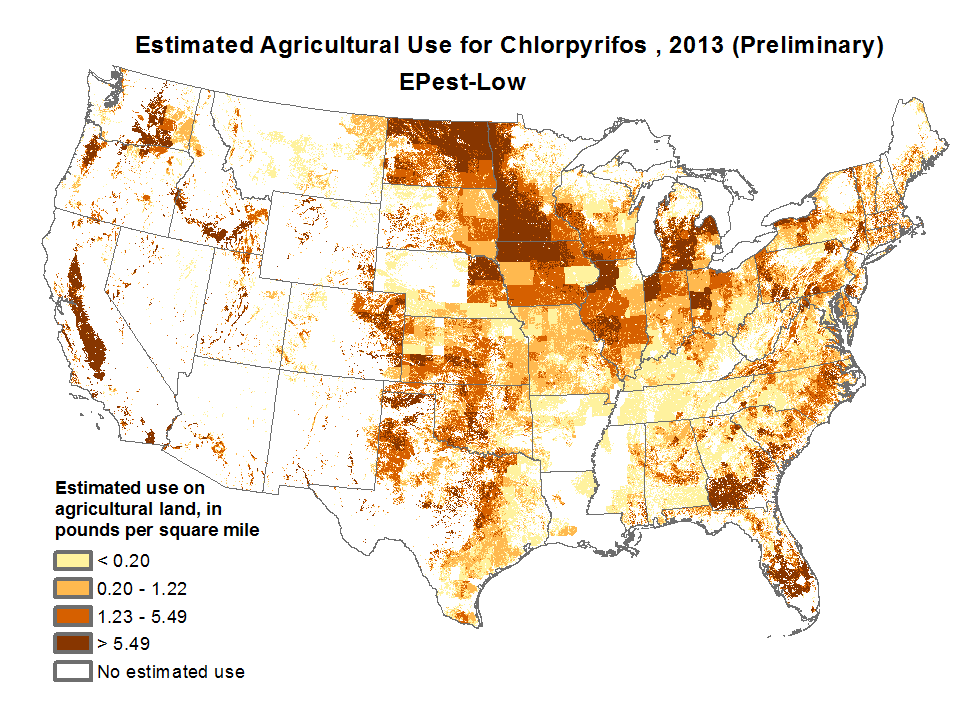12
Apr
EPA Finds 97% of Endangered Species Threatened by Common Pesticides
(Beyond Pesticides, April 12, 2016) Two commonly used pesticides are “likely to adversely affect” 97% of species listed under the Endangered Species Act (ESA), according to a first of its kind national assessment by the U.S. Environmental Protection Agency (EPA). The determination is part of a settlement reached by EPA and the Center for Biological Diversity, which requires the agency to complete a review of the impact of organophosphate pesticides chlorpyrifos, malathion, and diazinon by December 2017, and two carbamate class pesticides, methomyl and carbaryl, by the end of 2018. Under ESA Section 7, any agency action that it authorizes, funds, or carries out must find that it “is not likely to jeopardize the continued existence of any endangered species or threatened species or result in the destruction or adverse modification of habitat.”
 Under ESA, EPA is required to consult with the U.S. Fish and Wildlife Service (FWS) and National Marine Fisheries Service (NMFS) when registering a pesticide, in order to mitigate risks to endangered species. However, EPA routinely disregards this requirement, and has been sued numerous times for failing to ensure adequate protections for endangered species. Although CBD’s original lawsuit targeted potential pesticide impacts on California’s threatened red-legged frog, both parties agreed that a broader, national review would be more efficient for government agencies. This determination was influenced by a 2013 report from the National Academy of Sciences that identified deficiencies and provided recommendations for all the agencies involved in pesticide consultations. While a new process for handling ESA consultations was outlined in 2013, EPA continues to bring pesticides to market without adequate data on a chemical’s adverse effects.
Under ESA, EPA is required to consult with the U.S. Fish and Wildlife Service (FWS) and National Marine Fisheries Service (NMFS) when registering a pesticide, in order to mitigate risks to endangered species. However, EPA routinely disregards this requirement, and has been sued numerous times for failing to ensure adequate protections for endangered species. Although CBD’s original lawsuit targeted potential pesticide impacts on California’s threatened red-legged frog, both parties agreed that a broader, national review would be more efficient for government agencies. This determination was influenced by a 2013 report from the National Academy of Sciences that identified deficiencies and provided recommendations for all the agencies involved in pesticide consultations. While a new process for handling ESA consultations was outlined in 2013, EPA continues to bring pesticides to market without adequate data on a chemical’s adverse effects.
As the recent review shows, pesticide impacts are ubiquitous, with EPA finding chlorpyrifos and malathion “likely to adversely affect” 97% of listed and candidate species and diazinon “likely to adversely affect” 79% of endangered species. While all three chemicals are currently allowed for use in agriculture, chlorpyrifos and malathion’s impact is broader due to its allowance as a mosquito insecticide. EPA’s analysis required consideration of both direct impacts through dietary exposure as well as indirect impacts through prey. Adverse effects were far reaching, ranging from aquatic mammals like sea lions, to cave-dwelling spiders, and numerous listed birds.
EPA is currently considering restricting the use of chlorpyrifos in agricultural settings by revoking its food tolerances, as a result of a separate lawsuit launched by Pesticide Action Network North America and the Natural Resources Defense Council. Although glyphosate’s listing as a carcinogen received the most coverage at the time, the World Health Organization also determined that both diazinon and malathion are probably carcinogenic to humans. Diazinon’s determination was based on evidence of cancer from human agricultural studies, and tumors in rodent studies. Malathion’s determination was made based upon human agricultural studies and strong evidence of DNA or chromosomal damage.
This ESA assessment shows that these chemicals are not only toxic to humans, but put nearly every sensitive species in the United States in unacceptable danger. However, EPA’s process for registering pesticides continues to institute restrictions intended to mitigate risks, and does not function to protect the most vulnerable in biological systems. This current review strengthen calls from health and environmental groups to eliminate the use of old, toxic organophosphate pesticides. In a world where numerous risks to endangered species exist, from habitat modification and fragmentation, to climate change, enigmatic diseases, and overconsumption, eliminating toxic pesticide use represents a low-hanging fruit for biodiversity conservation.
Tried, tested and effective sustainable and organic alternatives exist for a nearly every use of toxic pesticides. For agriculture, organic systems build healthy soil and create biodiverse habitat which in turn develops hardier crops and a more resilient system better able to address pest outbreaks before they impact harvests. With mosquito control, an emphasis on prevention and source reduction is the most effective method of managing mosquitoes, as it focuses on stopping mosquitoes from hatching in the first place. Even in the very limited situations where adulticides are used for public health emergencies, highly toxic organophosphates like chlorpyrifos need not be employed.
For an in-depth discussion on the science and law behind pesticide registrations, attend Beyond Pesticides’ 34th National Pesticide Forum at the end of this week (April 15-16th) in Portland, Maine. The Environmental Health and Law panel will feature scientist and Beyond Pesticides Board member Warren Porter, Ph.D, entomologist Nancy Ostiguy, Ph.D, permaculture designer Tao Orion, and Center for Food Safety Senior Attorney Paige Tomaselli. Tickets are still available for purchase!
All unattributed positions and opinions in this piece are those of Beyond Pesticides.
Source: EPA, Center for Biological Diversity










